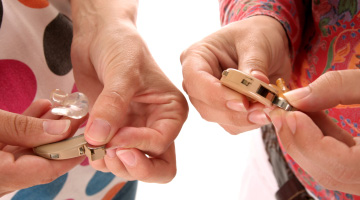 Hearing aids are complex digital devices that must be properly cared for to work their best. Since hearing aids are a major investment, it’s important to take the time to learn the right hearing aid care techniques for your devices.
Hearing aids are complex digital devices that must be properly cared for to work their best. Since hearing aids are a major investment, it’s important to take the time to learn the right hearing aid care techniques for your devices.
Hearing Aid Maintenance
We encourage you to take the time to clean your devices every day. First, wipe down all surfaces of the device with a soft, dry cloth. Never use water, solvents, cleaning fluids or alcohol on your hearing aids, as moisture will damage them if it reaches the electronic components. Use a cleaning tool or kit to reach all areas, paying specific attention to the tubing, battery contacts and wax filter.
While today’s hearing aids are sealed with a microscopically thin layer of waterproofing material, you should still take care to avoid exposing the devices to potentially harmful substances. For example, apply hairspray, moisturizer, sunscreen and lotions before inserting your hearing aids, and wash your face before inserting your hearing aids for the day.
Troubleshooting Tips
Since hearing aids are such intricate devices, they may malfunction from time to time. You may need to see your audiologist for repair in some situations, but you should try a few basic troubleshooting techniques at home first. Here are some tips for caring for your hearing aids at home:
- Feedback or whistling often occurs when your hearing aids are inserted incorrectly. Try removing and replacing them in your ears. If this does not resolve the issue, earwax might have accumulated and clogged the ports. Clean the devices thoroughly with your multi-tool or a wax pick.
- Distorted or unclear sound may occur when your battery or battery contacts are dirty or corroded. Try cleaning the battery surfaces or replacing the battery. You should also check to ensure your device isn’t actually set to telecoil mode.
- If there is no sound at all, start by replacing the battery and checking for a clogged microphone or sound outlet. You may also need to replace the wax filter.
Hearing Aid Batteries and Repairs
When you invest in hearing aids, your audiologist will spend time with you to ensure you understand how to get the most out of your devices. This will include going over how to change programs, control your devices, perform effective nightly cleanings, replace the batteries and take action if your device is malfunctioning. We offer many services at our Akron offices to help you adapt to life with hearing aids.
Hearing Aid Batteries
Most hearing aids use one of five types of batteries, each of which has a number and color assigned to it. This color system is designed to make battery shopping easy in any environment. Smaller batteries tend to have shorter lifespans, so you should always have many spare batteries on hand. You can purchase hearing aid batteries at most big box stores, drugstores, online or from your audiologist directly.
Hearing aid batteries should be stored at room temperature and left unopened until use. Hearing aids use zinc-air batteries that are activated when a small tab is pulled out of the battery, exposing it to air. Once you’ve activated your battery by pulling this tab, wait several seconds to allow it to fully charge before inserting it into your device. We recommend that you take your hearing aid batteries out each night in order to clean the battery and contacts as well as save battery life.
Hearing Aid Repair
Many basic hearing aid repairs can be performed in-office by your audiologist or a hearing instrument specialist. In some cases of a more complicated electronic repair, your audiologist will have to send the device to the manufacturer. You should spend time with your audiologist to ensure you fully understand the terms of your warranty after choosing a hearing aid in order to take full advantage of any repair options you have during your warranty period.


